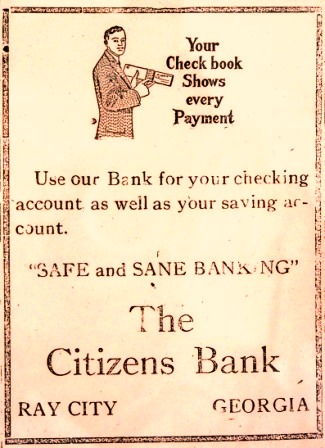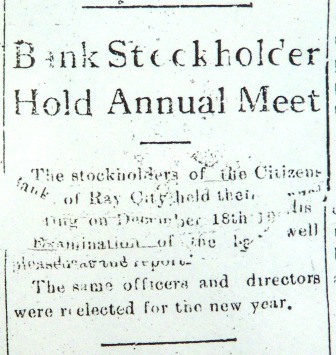Hyman Hardeman “Brocy” Sirmans (1919 – 1969) of Ray City, GA was a son of Mamie and Daniel W. Sirmans.
H. H. Sirmans was born on March 22, 1919 at Ray City just in time to be enumerated in the census of 1920. His father rented a farm on one of the settlement roads near Ray City. Next door was John and Anne Sirmans Matheny, and on the adjacent farm, George W. and Mary Fender.
http://www.archive.org/stream/georgiacensus00reel338#page/n372/mode/1up
Hyman H. Sirmans was enumerated in the Census of 1930 in his father’s household at Ray City, GA. He was 11 years old, and attended school along with his sisters Lerine and Victoria. Edith and Margaret were too young to attend.
http://www.archive.org/stream/georgiacensus00reel338#page/n372/mode/1up
Hyman H Sirmans worked on a Liberty Ship during WWII. His service records give his physical description as 5′ 6″ tall, and 228 pounds.
He began his service at sea in 1940, and served as a Fireman/Watertender on the S. S. William G. Lee. The William G. Lee liberty ship was built in Savannah, Georgia by the Southeastern Shipbuilding Corporation.
The Merchant Marine website provides the following:
“Liberty ship” was the name given to the EC2 type ship designed for “Emergency” construction by the United States Maritime Commission in World War II. Liberty ships were nicknamed “ugly ducklings” by President Franklin Delano Roosevelt.
The first of the 2,711 Liberty ships was the SS Patrick Henry, launched on Sept. 27, 1941, and built to a standardized, mass produced design. (2,710 ships were completed, as one burned at the dock.) The 250,000 parts were pre-fabricated throughout the country in 250-ton sections and welded together in about 70 days. One Liberty ship, the SS Robert E. Peary was built in four and a half days. A Liberty cost under $2,000,000.
The Liberty was 441 feet long and 56 feet wide. Her three-cylinder, reciprocating steam engine, fed by two oil-burning boilers produced 2,500 hp and a speed of 11 knots. Her 5 holds could carry over 9,000 tons of cargo, plus airplanes, tanks, and locomotives lashed to its deck. A Liberty could carry 2,840 jeeps, 440 tanks, or 230 million rounds of rifle ammunition.
As a Fireman/Watertender on the S.S. William G. Lee, H. H. Sirmans would have been responsible for tending to the fires and boilers in the steam ship’s engine room. His duties would have included tending the boilers to maintain steam at specified pressure, and regulating the amount of water in the boiler, observing gauges, and cleaning equipment and work area. He may have also done maintenance and repair work in the fireroom and engine room, and monitored operation of evaporators and condensers used to convert salt water to fresh water.
The William G. Lee was launched in July, 1944 and made numerous Atlantic crossings during WWII. According to the ConvoyWeb database for Merchant Ships during WW2, the William G. Lee departed from NYC on July 25, 1944 with Convoy HX.301, and arrived at Liverpool, England on August 8, 1944. She departed Methil, Scotland with Convoy FS.1541 on August 11,1944 for Southend, England, arriving on August 13, 1944. She departed Southend, England with Convoy FN.1455 on August 20, 1944, for Methil,Scotland. Two days later she departed Methil Scotland with Convoy EN.425 on August 22, 1944 bound for Loch Ewe, Scotland, arriving August 24. She joined Convoy ON.250 departing from Liverpool and arrived NYC on September 7, 1944. She departed from NYC on October 5, 1944 with Convoy HX.312, and arrived at Liverpool, England on October 21, 1944. She joined Convoy ON.267 departing Southend on November 18, 1944, and arrived NYC on December 5, 1944. She departed Boston, MA with Convoy BX.138 on December 21, 1944, arriving off Halifax on December 23. She joined Convoy HX.328 departing from NYC on Christmas Eve, 1944, arriving at Liverpool England on January 8, 1945. On January 10, 1945, she made the run from Southend with Convoy FN.1598, bound for Methil, Scotland. Nine days later, she made the return run with Convoy FS.1702. She departed Southend with Convoy ON.280 on January 22 1945, arrived NYC on 9 February 9, 1945. She joined Convoy HX.341 and departed NYC on February 28, 1945, arriving at Liverpool England on March 15, 1945. On 27 March 1945 she departed Southend with Convoy ON.293, and arrived NYC on April 15, 1945. She departed from NYC on May 3, 1945 with Convoy HX.354 and arrived Liverpool on 18 May 1945.
H. H. Sirmans married Marjorie E Garner in 1944 in Baker County, FL 1944 21268
LAKELAND, Ga. – H. H. (Brocy) Sirmans, 49, of Ray City, died at his home early today of an apparent heart attack.
He was born and lived all his life in Berrien County. He was a member of Ray City Baptist Church, the National Farmers Organization and the Farm Bureau.
Survivors are his wife the former Marjorie Garner; a daughter, Patricia Ann Sirmans of Valdosta; mother, Mrs. Mamie Sirmans of Ray City; four sisters, Mrs. Lerine Harris and Mrs. Margaret Stalvey and Mrs. Edith Peters of Ray City and Mrs. Victoria Bradly of Savannah.
Funeral services are to be held at 3 p. m. Wednesday at Ray City Baptist Church with burial at Beaver Dam Cemetery. The body is to be taken to the residence late today.
Music Funeral Home of Lakeland is in charge of arrangements.
Active pallbearers are to be Jackie Giddens, Murice Lankford, Marvin Harris, J. Bart Gaskins, Clyde Miller, Albert Studstill, James Swindle and Lonnie Plair.
Honorary pallbearers are to be Walter J. Gaskins, Billy Clements, Glen Lee, John David Luke, Lawson Fountain, Sam Barker, Joe Latham, Jack Knight, Herbert Allen, Thomas Patten and Leland Kent.













